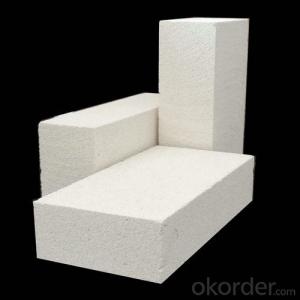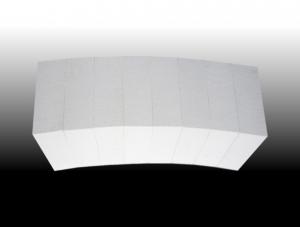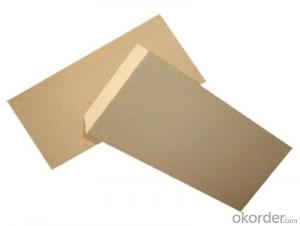Insulating Fire Brick - GJM26
- Loading Port:
- China Main Port
- Payment Terms:
- TT or L/C
- Min Order Qty:
- 1000 pcs pc
- Supply Capability:
- 1000 Tons Per Month pc/month
OKorder Service Pledge
OKorder Financial Service
You Might Also Like
General Information of Insulating Fire Brick GJM26
Insulating fire brick GJM26 are produced by high purity alumina and low iron raw materials. A viariety of
To make our firebricks more energy and cost effective, we have different manufacturing methods for our insulating fire bricks casting and extruding method.
For insulating fire bricks GJM28,we choose the extruding method. Extruding insulating fire bricks have better strength and offering great performance in load bearing applications and in conditions where abrasion from mechanical abuse or flow of hot gases.
Characteristics of Insulating Fire Brick GJM26
Our insulating fire bricks exhibit the following characteristics:
Light weight and low thermal conductivity allows thinner furnace walls
Low heat storage results in rapid cooling and heating operation
Low iron and impurities to enhance reducing atmosphere
Technical Data of Insulating fire bricks
|
| JM26 |
Physical Properties: |
|
|
Classifiction Temperature | ℃ | 1430.0 |
Density | Kg/m3 | 850.0 |
Cold Crushing Strength | Mpa | 2.0 |
Reheating Linear Change(24hrs) |
|
|
1400℃ | % | 0.5 |
Hot Load Strength Deform(90 minutes) |
|
|
1260℃ at 0.069 Mpa(10psi) | % | 0.2 |
Thermal Conductivity |
|
|
400℃ | W/m.k | 0.3 |
600℃ | W/m.k | 0.3 |
800℃ | W/m.k | 0.3 |
1000℃ | W/m.k | 0.3 |
1200℃ | W/m.k | 0.4 |
Specific Heat | KJ/Kg.K | 1.1 |
Chemical Analysis: |
|
|
Al2O3 | % | 50.0 |
SiO2 | % | 47.1 |
Fe2O3 | % | 0.7 |
TiO2 | % | 0.1 |
CaO | % | 0.1 |
MgO | % | 0.2 |
Na2O+K2O | % | 1.7 |
Typical Application of Insulating fire bricks
Ceramic shuttle kilns
Oil refinery heaters
Laboratory furnaces
Backup insulation for all furnaces
We has success in insulating fire bricks due to their cost-effectiveness, excellent insulation properties. CNBM also has experience in insulating fire bricks application and would like to assist you in product selection, system design, and installation techniques.
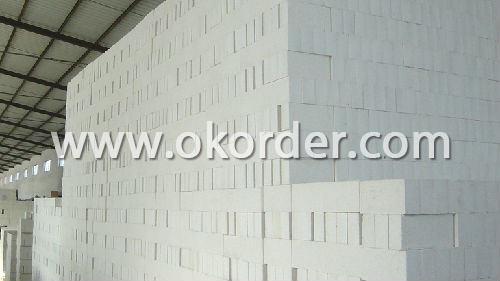
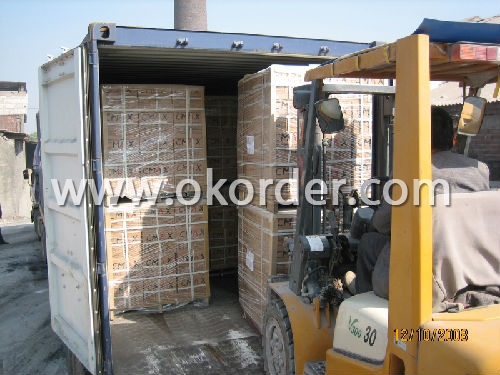
- Q: Can insulating fire bricks be used in the construction of glassware production furnaces?
- Yes, insulating fire bricks can be used in the construction of glassware production furnaces. These bricks have excellent thermal insulation properties and can withstand high temperatures, making them ideal for creating a well-insulated and efficient furnace for glass production.
- Q: Can insulating fire bricks be used as a refractory material?
- Yes, insulating fire bricks can be used as a refractory material. Insulating fire bricks are specifically designed to withstand high temperatures and thermal shock, making them suitable for applications that require heat insulation and refractory properties. They have low thermal conductivity, which helps to reduce heat loss and conserve energy. Insulating fire bricks are commonly used in various industries, including steel, glass, ceramics, and petrochemicals, where they are used as lining materials in furnaces, kilns, ovens, and other high-temperature equipment. Their ability to withstand extreme temperatures, coupled with their insulating properties, makes them an excellent choice for refractory applications.
- Q: Can insulating fire bricks be used for insulation in gas furnaces?
- Yes, insulating fire bricks can be used for insulation in gas furnaces. They are designed to withstand high temperatures and provide excellent insulation properties, making them suitable for use in gas furnaces to improve energy efficiency and enhance overall performance.
- Q: Can insulating fire bricks be used in chimneys?
- Yes, insulating fire bricks can be used in chimneys. These bricks are specifically designed to withstand high temperatures and provide excellent insulation, making them ideal for lining chimneys. They help to retain heat and prevent excessive heat transfer to the surrounding structure, enhancing the efficiency and safety of the chimney.
- Q: Are insulating fire bricks resistant to abrasion or erosion?
- Insulating fire bricks lack resistance to abrasion or erosion in general. Despite their exceptional heat insulation properties, they are typically constructed from materials that are not intended for enduring high levels of deterioration. Insulating fire bricks are commonly employed in scenarios that do not involve substantial mechanical forces or abrasive substances. If worries about abrasion or erosion arise, it may be more appropriate to consider an alternative refractory material or lining for the particular application.
- Q: Can insulating fire bricks be used in the construction of heat storage systems?
- Yes, insulating fire bricks can be used in the construction of heat storage systems. Insulating fire bricks are designed to have low thermal conductivity, which means they are capable of trapping and storing heat effectively. These bricks are made from materials such as fire clay, which have excellent insulation properties. By using insulating fire bricks, heat loss can be minimized, allowing for efficient heat storage and retention in heat storage systems. The bricks can be used to build the walls and lining of the heat storage system, ensuring that the stored heat is not dissipated to the surroundings. Additionally, insulating fire bricks are lightweight and easy to handle, making them a convenient choice for constructing heat storage systems. Overall, the use of insulating fire bricks in the construction of heat storage systems enhances their thermal efficiency and contributes to more effective heat management.
- Q: What is the typical porosity of an insulating fire brick?
- The typical porosity of an insulating fire brick is around 40% to 60%.
- Q: Can insulating fire bricks be used in high-velocity gas flow applications?
- Yes, insulating fire bricks can be used in high-velocity gas flow applications. Insulating fire bricks are designed to have excellent thermal insulation properties, low thermal conductivity, and high resistance to temperature fluctuations. These characteristics make them suitable for various high-temperature applications, including high-velocity gas flow environments. When exposed to high-velocity gas flow, insulating fire bricks can maintain their structural integrity and insulation properties, providing effective thermal insulation and protection. They are often used in applications such as kilns, furnaces, boilers, and other industrial equipment where high-velocity gas flow is present. However, it is important to consider the specific requirements and characteristics of the gas flow in the application. Factors such as temperature, pressure, and chemical composition of the gas should be taken into account to ensure that the insulating fire bricks are compatible and can withstand the conditions. In summary, insulating fire bricks can be used in high-velocity gas flow applications due to their thermal insulation properties and resistance to temperature fluctuations. However, it is crucial to consider the specific requirements and characteristics of the gas flow to ensure proper compatibility and performance.
- Q: Are insulating fire bricks resistant to gas permeability?
- Yes, insulating fire bricks are resistant to gas permeability. These bricks are designed to have low porosity and high density, which helps to prevent the penetration of gases through their structure. They are made from high-quality refractory materials, such as clay or silica, and are manufactured using a special process to ensure minimal pore size and tight packing. This makes them highly effective in containing gases and preventing their leakage. Insulating fire bricks are commonly used in various high-temperature applications, including furnaces, kilns, and industrial boilers, where gas tightness is essential for efficient and safe operations.
- Q: Can insulating fire bricks be used in the construction of smelting furnaces?
- Smelting furnaces can indeed utilize insulating fire bricks in their construction. These bricks have been specifically crafted to endure extreme temperatures and offer exceptional insulation, rendering them an impeccable choice for smelting furnaces. Their low thermal conductivity aids in minimizing heat dissipation and upholding a steady temperature within the furnace. Moreover, these bricks are lightweight, which facilitates their handling and installation. All in all, incorporating insulating fire bricks in the construction of smelting furnaces can enhance energy efficiency, diminish operational expenses, and elevate the overall furnace performance.
1. Manufacturer Overview
| Location | Jiangsu, China |
| Year Established | 2008 |
| Annual Output Value | Above US$ 35 Million |
| Main Markets | Germany; Italy; Turkey; France; England; Japan; Thailand; Vietnam; Idonesia; USA |
| Company Certifications | ISO 9001:2008 |
2. Manufacturer Certificates
| a) Certification Name | |
| Range | |
| Reference | |
| Validity Period |
3. Manufacturer Capability
| a) Trade Capacity | |
| Nearest Port | Shanghai; Qingdao |
| Export Percentage | 10% |
| No.of Employees in Trade Department | 3 People |
| Language Spoken: | English; Chinese; |
| b) Factory Information | |
| Factory Size: | Twenty five thousand tons per year |
| No. of Production Lines | Above 5 |
| Contract Manufacturing | OEM Service Offered; Design Service Offered |
| Product Price Range | High; Average |
Send your message to us
Insulating Fire Brick - GJM26
- Loading Port:
- China Main Port
- Payment Terms:
- TT or L/C
- Min Order Qty:
- 1000 pcs pc
- Supply Capability:
- 1000 Tons Per Month pc/month
OKorder Service Pledge
OKorder Financial Service
Similar products
Hot products
Hot Searches
Related keywords















